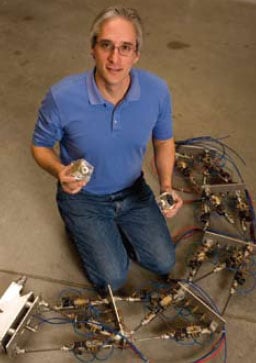 Underneath a lab bench in the Computational Science and Engineering building sits a snakelike five-foot-long robotic arm, a collection of triangular metal shapes, pneumatic cylinders, and aluminum tubes linked together in an integrated truss structure. It has no name, but “Adam” would be apt.
Underneath a lab bench in the Computational Science and Engineering building sits a snakelike five-foot-long robotic arm, a collection of triangular metal shapes, pneumatic cylinders, and aluminum tubes linked together in an integrated truss structure. It has no name, but “Adam” would be apt.
Adam is a binary manipulator. Basically, he picks things up. But that is not what makes him special. Adam holds the honor of being the first robot built at Johns Hopkins.
The history of robotics at the Whiting School traces back to the early 1990s and Adam’s creator, Gregory S. Chirikjian ’88, BA/ BS/MSE, a professor of mechanical engineering. Before Chirikjian’s arrival, Hopkins dabbled in robotics—as far back as the 1960s—but lagged behind its peers in the field. Bill Sharpe, PhD ’66, set out to change all that.
Sharpe, the Alonzo G. Decker Professor of Mechanical Engineering, joined Johns Hopkins in January 1983 to jump-start the reformed Department of Mechanical Engineering. For the department’s first open house, Sharpe procured a small Rhino robot arm. “All it did was pick up a business card and put it another pile: Just do this over and over,” Sharpe recalls.
It was enough to impress a 17-year-old Chirikjian. Drawn by the promise of robotics, Chirikjian enrolled at Johns Hopkins to pursue degrees in engineering mechanics, mathematics, and mechanical engineering. He went on to earn a doctorate in applied mechanics from the California Institute of Technology, where he studied under Joel Burdick, a pupil of such heavyweights as Bernard Roth and Ferdinand Freudenstein, the “father of modern kinematics.”
In 1992, after his graduation, Chirikjian called Sharpe to inquire about job opportunities. Talk about perfect timing. “At that time, other robotics research labs were well established at places like Stanford and Carnegie Mellon,” Sharpe says. “We felt we needed to broaden our activities and move into this area. Hiring Greg was the official start of robotics here.”
At Hopkins, Chirikjian has pioneered the theory of “hyper-redundant” (snakelike) robot motion planning and self-replicating robotic systems. He also designs and builds hyper-redundant robotic manipulator arms, of which Adam was the first. Snakelike motion is particularly useful for inspection in highly constrained environments (think: outer space), and for using the arm to wrap around objects, he says.
“When I started, most robot arms were heavy and expensive,” Chirikjian explains. “My work with binary robots is focused on making inexpensive, lightweight, and reliable robot arms that can have many applications, such as to assist people with disabilities.”
In 1993, the Whiting School hired Louis Whitcomb, an expert in applied mechanical robotic systems. Today, a professor of mechanical engineering, Whitcomb and his Dynamical Systems and Control Laboratory are leading the way in the development of machines that interact dynamically with their environments, in particular underwater robots for deep ocean exploration.
Sharpe says the final piece of the robotics puzzle fell into place in 1995, with the hire of Russell Taylor, a robotic systems expert who established the Computer-Assisted Surgery Group at IBM Research. Taylor has spearheaded the Whiting School’s efforts in the field of medical robotics, creating computer-assisted microsurgical assistants that allow for less invasive procedures and ones previously thought impossible.
The combined contributions of Chirikjian, Whitcomb, and Taylor have allowed the Whiting School to become, in just 15 years, a leader in robotics research, says Sharpe.
“The strategy all along has been to look for the ‘best athlete,’ the strongest candidate regardless of the area,” Sharpe said. “It so happens we’ve been able to lure here some of the leading robotics researchers in the world.” Another “star athlete” is Greg Hager, who joined Johns Hopkins in 1999. Hager, a professor of computer science and director of the Computational Interaction and Robotics Lab, specializes in computer vision with applications in medical devices and human-machine systems.
What does the future hold for robotics at Hopkins? Sharpe sees the development of many more applications in medical robotics. He said that rising faculty stars such as Allison Okamura and Noah Cowan are designing systems to amplify and assist human physical capabilities.




